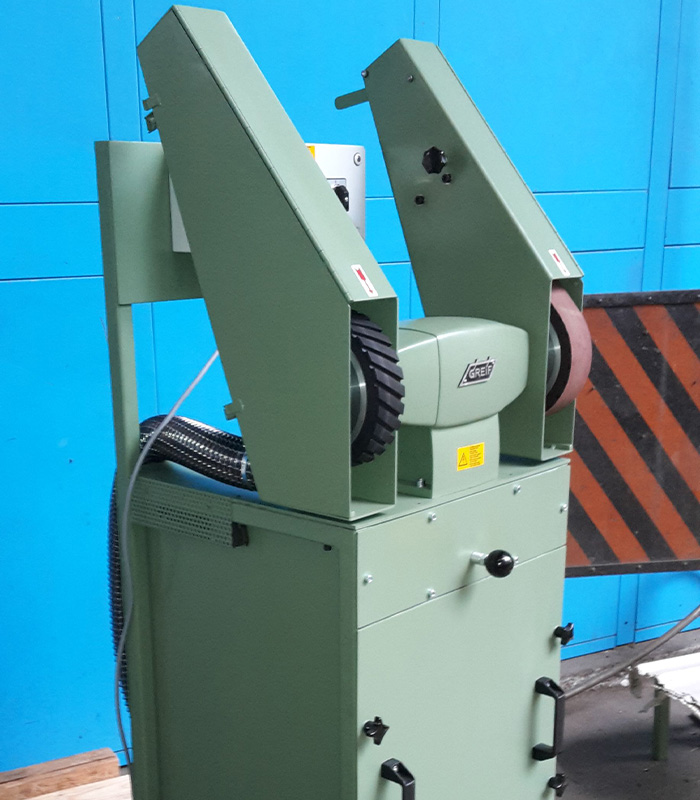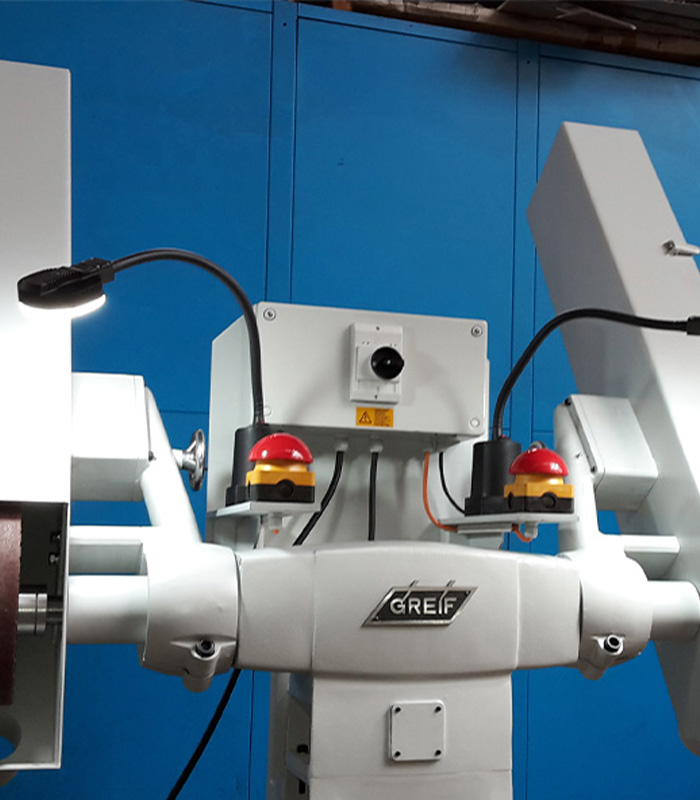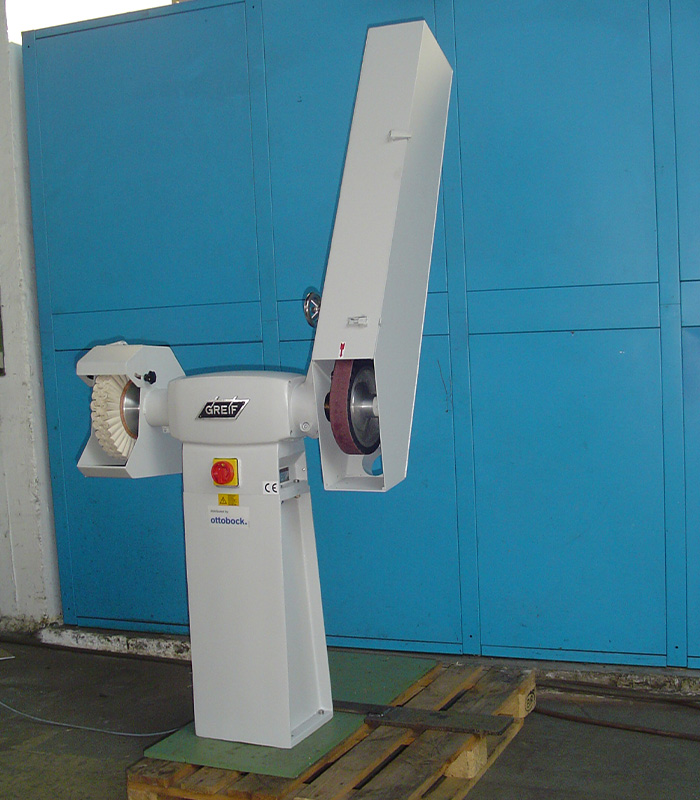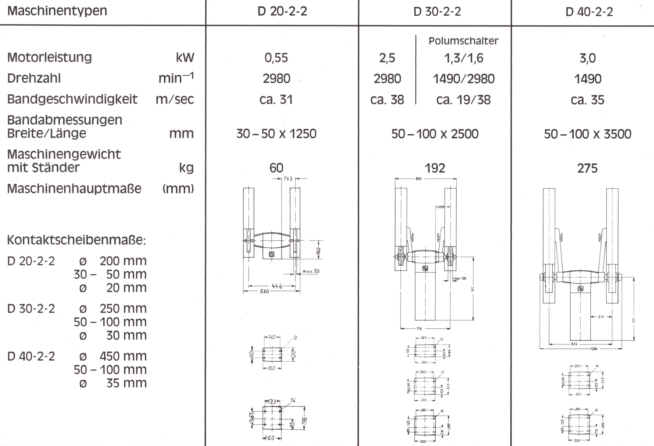
Picture 1
Everything made of sturdy material
.The fact that GREIF does not engage in cheap sheet metal cobbling is already proven by the unit weight of each machine model. The machine frame and motor housing are sturdy cast bodies that contribute significantly to the smooth running and noise reduction of the machines. The motors have cast-on bearing end caps for better sealing against grinding dust, and their power prevents belt stoppage and belt breakage even at high grinding pressure.
.

Picture 2
The shape is not only a matter of form
.The harmonious lines, which you will also find in detail at GREIF, determine not only the aesthetics, but above all the function of the grinding machines. For example, the modern motor design is characterized by the combination of square cross-sections in two planes with circular arcs of different radii overlapping the edges, through which a much larger surface area is achieved than with a cylindrical motor. The result is optimum heat dissipation to the surrounding air.

Picture 3
Powerful and universal
GRElF belt grinders are designed for high metal removal rates in industrial operations. However, they are also ideally suited for deburring tasks and the grinding of weld seams, for fettling castings, etc. The grinding performance is the result of proven belt grinding factors:
- High grinding belt speeds due to an optimal combination of motor speed and dimensioning of the drive and contact wheels (200 to 450 mm diameter);
.
- Large abrasive belt lengths (1250 to 3500 mm) to ensure sufficient abrasive grain cooling until the next operation and thus a long belt service life;
- Easy abrasive belt handling due to a handwheel located outside the belt guard box for belt run regulation as well as a telescopic quick release lever for abrasive belt change
.

Picture 4
Developed for special tasks: Turbine roller head (R1)
This special belt grinding device can be used for a wide variety of tasks where small contact wheels are required, such as turbine blade grinding.
Contact wheels with diameters of 15-50 mm and widths of 15-50 mm can be mounted on the belt tensioning arm using quick-change adapters. Because of the extremely high speeds, the contact rolls are equipped with air cooling as well as lubrication for the bearings. With small contact wheels and narrow grinding belts, deburring of tube ends, inside and outside, is also possible. Fig. 4 shows an example of a design in which small radii are ground on turbine blades.

Picture 6
When sanding: dust disposal inevitable
.The extraction nozzle built into the sanding belt protection box uses the fan effect of the belt run by intercepting sparks and sanding dust to a large extent in their direction of flight. When connected to a dust collection system sized appropriately for the sanding capacity, the complete system ensures extensive dust removal.
For the smaller type D 20-2-2, it is usually sufficient to use the MS-10 dust extraction unit designed as a machine stand (Fig. 1). The sturdy steel housing contains a specially designed filter bag made of flame-resistant material, a fan with motor drive, and a conveniently handled dust box.
The dust bag is made of flame-resistant material.The fan impeller is driven by a 0.75 kW motor at 2880 min-l. With clean filter bags, the capacity measured at the filter inlet is 115 mm wc and 9 cbm/min.

Picture 6
Various additional devices
The continuously inclinable BA 25 belt tensioning arm can be equipped with additional devices for a wide variety of tasks on machine types D 30 and D 40, in particular with interchangeable roller heads:
- Turbine roller head (R 1) for grinding small radii, e.g. on turbine blades or hard-to-reach places on bulky parts
.
- Contact roller head (R 2) with roller diameters from 50 to 125 mm for grinding curved surfaces
.
- Finger roller head (R 3) for internal grinding of hollow bodies and profiles up to an inside width of approx. 35×35 mm or 45 mm diameter;
.
- Double roller head (R 4) for grinding the outer circumference of round parts
.
Powerful, precise and durable: the GREIF motor
.
GREI motors run smoothly even after 50,000 hours of operation. Each one is extremely resilient and surprisingly quiet. This is the result of decades of experience in engine construction (since 1928). Rigidity and precision, which determine the work result, are a matter of course for GREIF motors:
Precision ground
The precision-ground and dynamically balanced motor shafts are accommodated in deep groove ball bearings, which are adjusted against each other as non-locating bearings and are under axial spring tension. This results in low noise, long service life and precise concentricity.
Range
The clamping width at the shaft end is designed so generously that polishing wheels or brushes can also be clamped in place of the contact wheel. The differences in width are bridged by spacer rings. The rotary or holding torque is transmitted by a set collar with a feather key. Tightening takes place via an internal thread at the shaft end which is protected against damage and corrosion. The selected material pairing prevents seizure of the rings and facilitates handling.
Cooling
The motors are internally cooled, with the air circulated by the rotor and fan absorbing the heat from the stator and releasing it to the housing and stator walls. The worker is not disturbed by any drafts.

